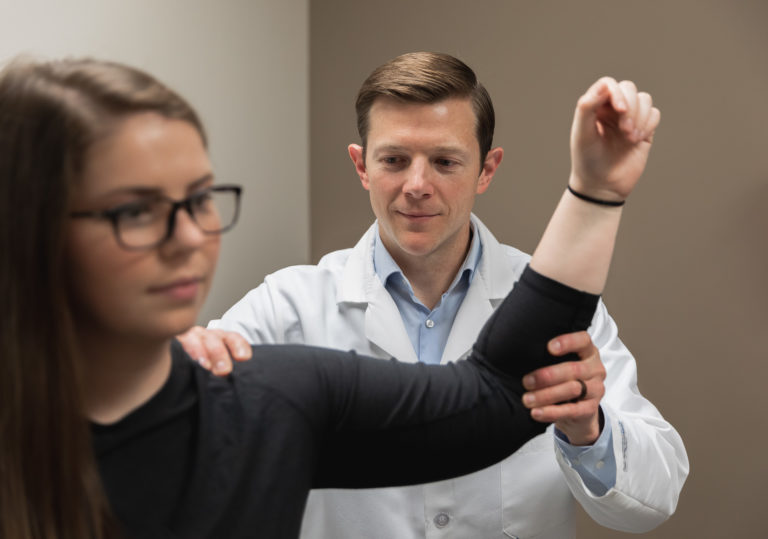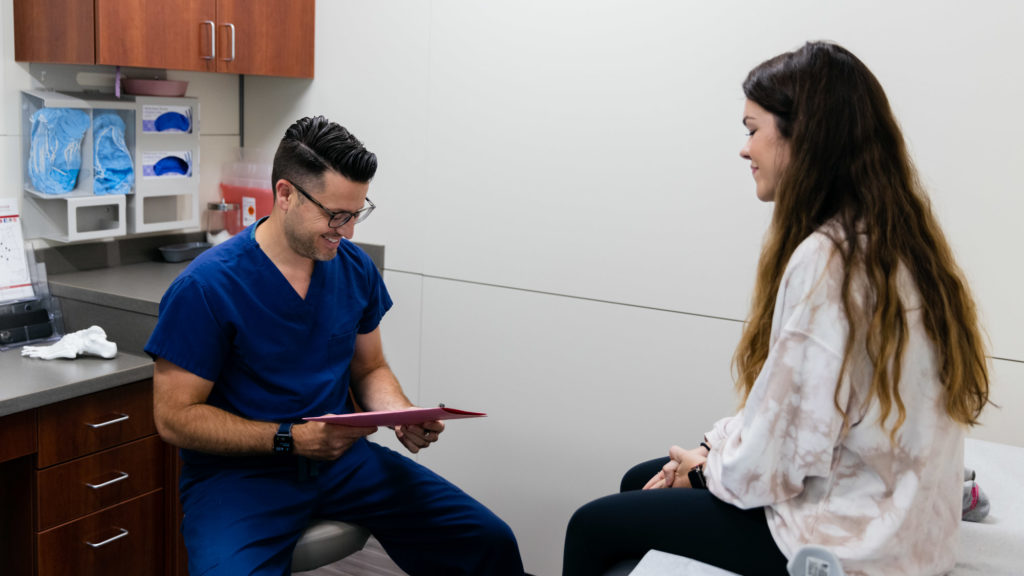Football season is here, which means many high school and college athletes are competing on the field. While football season can be an exciting time for players, coaches and fans, it can also bring about anxiety for parents, who worry about their athlete’s risk of sustaining sports injuries.
Although it can be hard to avoid injuries when participating in high-impact sports, there are several steps athletes can take to reduce the risk of permanent damage, loss of function or re-injury, including seeking immediate treatment from a physician who specializes in sports medicine. Below we discuss five of the most common types of football-related musculoskeletal injuries and possible treatment options associated with each condition.
Common Knee Injuries
Sprained or Torn Anterior Cruciate Ligament (ACL)
 ACL injuries, including sprained or torn ACLs, are among the most common football-related knee injuries. The ACL is like a rope that runs from the femur to the tibia and helps stabilize the knee. When an athlete lands incorrectly or changes direction suddenly, it can put pressure on the ACL and cause the ligament to tear or rupture. Collisions between players can also cause ACL injuries.
ACL injuries, including sprained or torn ACLs, are among the most common football-related knee injuries. The ACL is like a rope that runs from the femur to the tibia and helps stabilize the knee. When an athlete lands incorrectly or changes direction suddenly, it can put pressure on the ACL and cause the ligament to tear or rupture. Collisions between players can also cause ACL injuries.
Treatment for ACL tears vary depending on the severity of the damage. If necessary, an orthopedic surgeon can replace the ACL using a tendon from somewhere else in the patient’s body or with tissue from the tissue bank (a process that is very similar to receiving blood). Other, nonsurgical treatment options include but are not limited to physical therapy, braces and anti-inflammatories.
Torn Meniscus
Football players also face an increased risk of meniscus tears—injuries that are often associated with other knee conditions, including ACL injuries. When an athlete turns quickly to run or catch a ball, the knee can twist, resulting in a torn meniscus.
Depending on the extent of the tear, nonsurgical treatment such as physical therapy or anti-inflammatory medication may be an option. In some cases, arthroscopy may be needed to fully repair the damage. If left untreated, the meniscus can become unstable, which can cause the knee to slip, pop or lock.
Common Shoulder Injuries
Dislocated Shoulder
 The shoulder is one of the body’s most mobile joints, which also makes it susceptible to football injuries. A dislocated shoulder occurs when the upper part of the arm bone pops out of the shoulder socket. Symptoms include pain, loss of strength, decreased range of motion, and catching, locking or popping of the shoulder.
The shoulder is one of the body’s most mobile joints, which also makes it susceptible to football injuries. A dislocated shoulder occurs when the upper part of the arm bone pops out of the shoulder socket. Symptoms include pain, loss of strength, decreased range of motion, and catching, locking or popping of the shoulder.
To treat a dislocated shoulder, a physician may gently push the ball of the shoulder joint back into the socket through a process called a closed reduction. Additional treatment options may include physical therapy, immobilization, braces/splints or medication. On rare occasions, shoulder surgery may be recommended for athletes who experience shoulder instability due to recurring dislocations. If left untreated, shoulder injuries can significantly restrict movement in the entire arm and increase the risk of re-injury.
Torn Rotator Cuff
Rotator cuff tears are also common among football players. These injuries are typically caused by player-to-player contact or collisions as well as overuse.
While shoulder surgery is sometimes the best option, there are alternatives. Depending on the athlete’s age and severity of the tear, nonsurgical treatment may include medication, steroid injections or physician-directed physical therapy.
Common Foot & Ankle Injuries
Ankle Sprains and Strains
 In addition to knee and shoulder injuries, football players also face an increased risk of ankle injuries, including sprains and strains. Ankle sprains and strains can occur in people of all ages and walks of life, but they are especially common among athletes. Without proper treatment, a severe ankle sprain can lead to instability and increase the risk of re-injury. Recurrent ankle sprains can also cause chronic pain and ankle arthritis.
In addition to knee and shoulder injuries, football players also face an increased risk of ankle injuries, including sprains and strains. Ankle sprains and strains can occur in people of all ages and walks of life, but they are especially common among athletes. Without proper treatment, a severe ankle sprain can lead to instability and increase the risk of re-injury. Recurrent ankle sprains can also cause chronic pain and ankle arthritis.
As with any sports-related injury, treatment varies depending on the severity of the damage—which is often identified by the amount of pain, swelling and/or bruising around the ankle. In most cases, ankle sprains can be treated without surgery. Nonsurgical treatment options include physical therapy, immobilization, ice (to reduce swelling) and anti-inflammatory medication. If the athlete has a torn ligament or ruptured muscle, ankle arthroscopy or surgery may be recommended.
Depending on the diagnosis, interventional physiatry may also be a treatment option for football injuries. Our physical medicine and rehabilitation physicians (also known as interventional physiatrists) specialize in treating and managing painful symptoms related to a variety of sports-related injuries. Through electromyography (EMG), nerve conduction studies, diagnostic imaging and other tests, they identify the source of the athlete’s pain or discomfort and design an individualized, nonsurgical treatment plan. Regardless of the type of injury, it is important to follow the recommended treatment plan carefully throughout recovery in order to return to play safely and efficiently.
Physicians who specialize in treating football injuries at Dickson-Diveley Orthopaedics include:
- Stanley A. Bowling, M.D.
- C. Lan Fotopoulos, M.D.
- James P. Halloran, M.D.
- Lowry Jones, Jr., M.D.
- Steven T. Joyce, M.D.
- Charles E. Rhoades, M.D.
- Fermin J. Santos, M.D.
- Thomas L. Shriwise, M.D.
- Mark J. Winston, M.D.
To learn more about sports medicine at Dickson-Diveley Orthopaedics, please contact us.
***
The medical information contained in the Dickson-Diveley Orthopaedics website is provided to increase your knowledge and understanding of orthopedic conditions. This information should not be interpreted as a recommendation for a specific medical or surgical treatment plan. As each patient may have specific symptoms or associated problems, the treatment regimen for a specific patient may not be the proper treatment for another.
Gaining knowledge and understanding of a particular problem or condition is the first step in any medical treatment plan. We believe the information presented on our website will be helpful for those individuals experiencing hand and wrist diseases, injuries, or other related problems. However, this information is not intended to replace the advice of your family physician. You are encouraged to consult with your physician to discuss any course of treatment presented or suggested.


